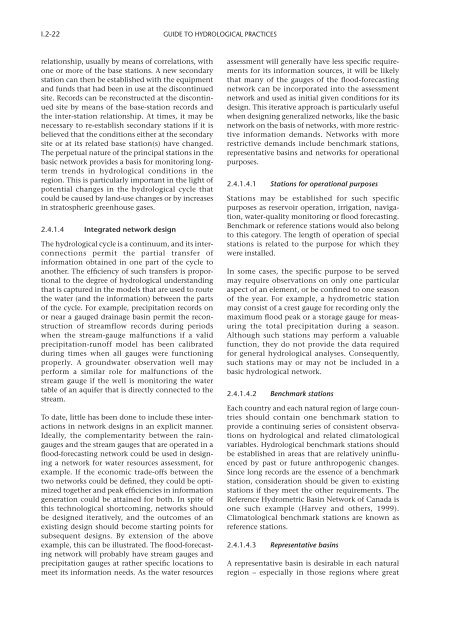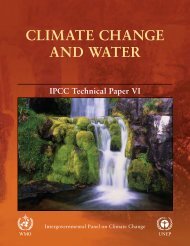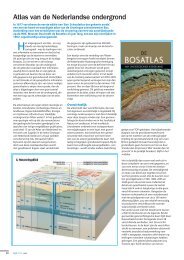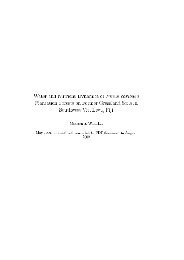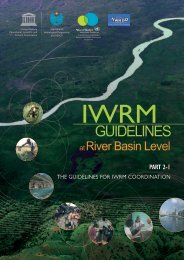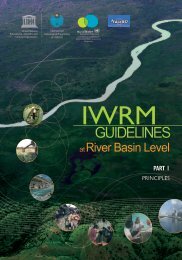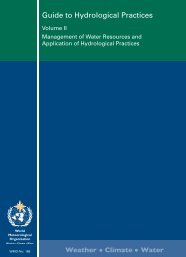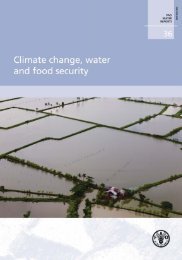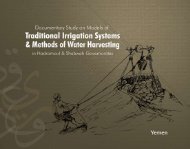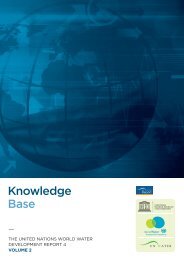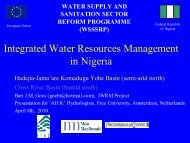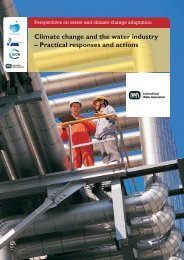Guide to Hydrological Practices, 6th edition, Volume I - Hydrology.nl
Guide to Hydrological Practices, 6th edition, Volume I - Hydrology.nl
Guide to Hydrological Practices, 6th edition, Volume I - Hydrology.nl
You also want an ePaper? Increase the reach of your titles
YUMPU automatically turns print PDFs into web optimized ePapers that Google loves.
I.2-22<br />
GUIDE TO HYDROLOGICAL PRACTICES<br />
relationship, usually by means of correlations, with<br />
one or more of the base stations. A new secondary<br />
station can then be established with the equipment<br />
and funds that had been in use at the discontinued<br />
site. Records can be reconstructed at the discontinued<br />
site by means of the base-station records and<br />
the inter-station relationship. At times, it may be<br />
necessary <strong>to</strong> re-establish secondary stations if it is<br />
believed that the conditions either at the secondary<br />
site or at its related base station(s) have changed.<br />
The perpetual nature of the principal stations in the<br />
basic network provides a basis for moni<strong>to</strong>ring longterm<br />
trends in hydrological conditions in the<br />
region. This is particularly important in the light of<br />
potential changes in the hydrological cycle that<br />
could be caused by land-use changes or by increases<br />
in stra<strong>to</strong>spheric greenhouse gases.<br />
2.4.1.4 Integrated network design<br />
The hydrological cycle is a continuum, and its interconnections<br />
permit the partial transfer of<br />
information obtained in one part of the cycle <strong>to</strong><br />
another. The efficiency of such transfers is proportional<br />
<strong>to</strong> the degree of hydrological understanding<br />
that is captured in the models that are used <strong>to</strong> route<br />
the water (and the information) between the parts<br />
of the cycle. For example, precipitation records on<br />
or near a gauged drainage basin permit the reconstruction<br />
of streamflow records during periods<br />
when the stream-gauge malfunctions if a valid<br />
precipitation-runoff model has been calibrated<br />
during times when all gauges were functioning<br />
properly. A groundwater observation well may<br />
perform a similar role for malfunctions of the<br />
stream gauge if the well is moni<strong>to</strong>ring the water<br />
table of an aquifer that is directly connected <strong>to</strong> the<br />
stream.<br />
To date, little has been done <strong>to</strong> include these interactions<br />
in network designs in an explicit manner.<br />
Ideally, the complementarity between the raingauges<br />
and the stream gauges that are operated in a<br />
flood-forecasting network could be used in designing<br />
a network for water resources assessment, for<br />
example. If the economic trade-offs between the<br />
two networks could be defined, they could be optimized<br />
<strong>to</strong>gether and peak efficiencies in information<br />
generation could be attained for both. In spite of<br />
this technological shortcoming, networks should<br />
be designed iteratively, and the outcomes of an<br />
existing design should become starting points for<br />
subsequent designs. By extension of the above<br />
example, this can be illustrated. The flood-forecasting<br />
network will probably have stream gauges and<br />
precipitation gauges at rather specific locations <strong>to</strong><br />
meet its information needs. As the water resources<br />
assessment will generally have less specific requirements<br />
for its information sources, it will be likely<br />
that many of the gauges of the flood-forecasting<br />
network can be incorporated in<strong>to</strong> the assessment<br />
network and used as initial given conditions for its<br />
design. This iterative approach is particularly useful<br />
when designing generalized networks, like the basic<br />
network on the basis of networks, with more restrictive<br />
information demands. Networks with more<br />
restrictive demands include benchmark stations,<br />
representative basins and networks for operational<br />
purposes.<br />
2.4.1.4.1 Stations for operational purposes<br />
Stations may be established for such specific<br />
purposes as reservoir operation, irrigation, navigation,<br />
water-quality moni<strong>to</strong>ring or flood forecasting.<br />
Benchmark or reference stations would also belong<br />
<strong>to</strong> this category. The length of operation of special<br />
stations is related <strong>to</strong> the purpose for which they<br />
were installed.<br />
In some cases, the specific purpose <strong>to</strong> be served<br />
may require observations on o<strong>nl</strong>y one particular<br />
aspect of an element, or be confined <strong>to</strong> one season<br />
of the year. For example, a hydrometric station<br />
may consist of a crest gauge for recording o<strong>nl</strong>y the<br />
maximum flood peak or a s<strong>to</strong>rage gauge for measuring<br />
the <strong>to</strong>tal precipitation during a season.<br />
Although such stations may perform a valuable<br />
function, they do not provide the data required<br />
for general hydrological analyses. Consequently,<br />
such stations may or may not be included in a<br />
basic hydrological network.<br />
2.4.1.4.2 Benchmark stations<br />
Each country and each natural region of large countries<br />
should contain one benchmark station <strong>to</strong><br />
provide a continuing series of consistent observations<br />
on hydrological and related clima<strong>to</strong>logical<br />
variables. <strong>Hydrological</strong> benchmark stations should<br />
be established in areas that are relatively uninfluenced<br />
by past or future anthropogenic changes.<br />
Since long records are the essence of a benchmark<br />
station, consideration should be given <strong>to</strong> existing<br />
stations if they meet the other requirements. The<br />
Reference Hydrometric Basin Network of Canada is<br />
one such example (Harvey and others, 1999).<br />
Clima<strong>to</strong>logical benchmark stations are known as<br />
reference stations.<br />
2.4.1.4.3 Representative basins<br />
A representative basin is desirable in each natural<br />
region – especially in those regions where great


